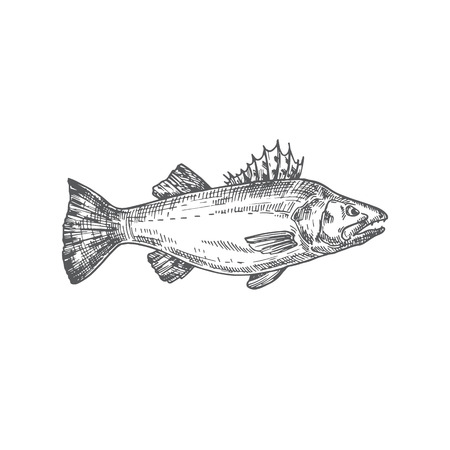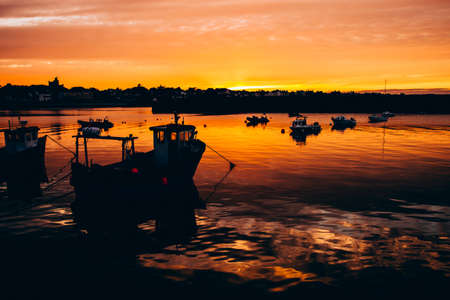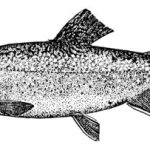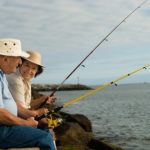Understanding Seasonal Behavior of Northern Pike and Muskie
To successfully catch Northern Pike and Muskie throughout the year, it’s important to understand how their behavior changes with the seasons. Water temperature, spawning cycles, and prey availability all play a major role in determining where these fish are and how active they’ll be.
Spring: Spawning Season
As ice melts and water temperatures rise into the low 40s (°F), both Northern Pike and Muskie move into shallow waters to spawn. This is one of the best times to locate them because they’re concentrated in predictable areas like bays, marshes, and shallow flats with vegetation or rocky bottoms.
Key Spring Behaviors:
- Northern Pike: Spawn early, often immediately after ice-out. Found in water as shallow as 1–5 feet.
- Muskie: Spawn slightly later when water hits 50-60°F. Tend to use similar shallow habitats but may be more scattered.
Summer: Feeding Phase
In summer, both species move to deeper, cooler waters as surface temps increase. They become more aggressive feeders during this time, making it a prime season for anglers targeting trophies.
Typical Summer Locations:
| Species | Preferred Depth | Common Areas |
|---|---|---|
| Northern Pike | 10–20 feet | Weed edges, drop-offs, submerged structure |
| Muskie | 15–30 feet | Main lake basins, points, deep weed lines |
Fall: Pre-Winter Feed-Up
As temperatures drop again in fall (mid 50s–40s °F), both pike and muskie go on a feeding binge to prepare for winter. They often return to shallower waters and are more likely to strike larger baits that mimic bulky prey like suckers or perch.
Bait Tip:
This is the time to throw big jerkbaits, swimbaits, or live bait rigs. Focus on transition zones—areas where shallow flats meet deeper basins.
Winter: Slowed Activity
During winter, cold water slows down their metabolism. While ice fishing can still produce results for Northern Pike (Muskie fishing under ice is restricted in many states), success depends on precise location and timing.
Northern Pike Winter Habits:
- Tend to hold near remaining green weeds or basin edges.
- Best caught during midday when light penetration warms the water slightly.
Seasonal Summary Table:
| Season | Pike Behavior | Muskie Behavior |
|---|---|---|
| Spring | Shallow spawning; very active post-spawn | Lags behind pike; starts feeding after spawn ends |
| Summer | Migrates deeper; feeds aggressively on baitfish | Pursues large prey near structure; prefers stable weather patterns |
| Fall | Binge feeds; returns to shallows briefly | Larger baits work best; often caught during overcast days or before fronts |
| Winter | Semi-dormant; slow presentations needed for ice fishing success | Largely inactive or off-limits depending on local regulations |
By recognizing how seasonal changes affect Northern Pike and Muskie movement and feeding habits, anglers can significantly improve their chances of landing a trophy fish year-round.
2. Spring Strategies: Post-Spawn Patterns and Shallow Action
As spring rolls in and water temperatures begin to rise, Northern Pike and Muskie enter the post-spawn phase. This is a prime window for anglers because both species become more aggressive and start feeding actively to recover energy. One of the best places to find them during this time is in shallow flats and warm bays where baitfish are also gathering.
Why Focus on Shallow Water?
Shallow areas warm up faster than deeper parts of the lake or river, which attracts smaller fish—and where the baitfish go, predators follow. Pike and Muskie often cruise these areas during post-spawn looking for easy meals. Targeting them here increases your odds of success because they’re active and easier to spot in clear water.
Best Lure Types for Spring Fishing
In early spring, the fish are still recovering from the spawn, so they may not chase fast-moving lures. Slow-moving presentations tend to work better because they give these apex predators a chance to strike without expending too much energy. Here’s a quick guide to effective lures during this season:
| Lure Type | Recommended Usage | Notes |
|---|---|---|
| Soft Plastics (Swimbaits) | Slow retrieve near weed edges | Mimics injured baitfish |
| Spoon Baits | Lift-and-drop action in shallow flats | Flashes attract attention in murky water |
| Suspending Jerkbaits | Twitch-pause-twitch technique near structure | Pauses trigger reaction strikes |
Top Locations to Target
Look for quiet back bays, shallow coves, and flats with emerging vegetation. These areas offer cover for baitfish and ambush points for predators like Pike and Muskie. Don’t overlook downed trees, submerged logs, or rocky points—they’re all potential hotspots.
Pro Tip:
Use polarized sunglasses to spot fish cruising in the shallows. Often you’ll see them before they see you—giving you a chance to make a perfect cast.
Ideal Gear Setup
- Rod: Medium-heavy to heavy action spinning or baitcasting rod (7’–8’)
- Reel: High-capacity reel with smooth drag system
- Line: 50–80 lb braided line with fluorocarbon leader (for abrasion resistance)
The spring bite can be one of the most exciting times of year for Northern Pike and Muskie anglers. With patience, stealthy movement, and the right presentation, you can hook into some real giants lurking just beneath the surface.

3. Summer Tactics: Deep Water and Weedline Techniques
When summer hits and water temperatures climb, Northern Pike and Muskie shift their patterns. They often move to deeper, cooler areas or hang out near the edges of weed beds where baitfish gather. To successfully target these apex predators during this season, anglers need to adapt their strategies to match the behavior of these fish.
Where to Find Them in Summer
Pike and Muskie are ambush predators, and in warmer months they look for comfort zones that offer both food and cover. Key locations include:
| Location | Why It Works |
|---|---|
| Weed Edges | Baitfish hide here, making it a prime hunting ground for predators. |
| Drop-offs | Sudden depth changes attract fish seeking cooler water and prey transitions. |
| Deep Water Structures | Submerged humps, channels, and points offer cooler temps and steady food supply. |
Lure Selection: Speed Is Key
In summer, Pike and Muskie are more active and willing to chase. Fast-moving lures trigger reaction strikes as these fish aggressively defend their territory or hunt for food. Here are some go-to lure options:
- Bucktail Spinners: Retrieve them quickly along weedlines or over drop-offs.
- Topwater Baits: Ideal for early mornings or evenings when fish move shallow briefly.
- Crankbaits: Use deep-diving models to reach suspended fish near structure.
Trolling Techniques That Work
Trolling is a highly effective way to cover water and locate roaming Muskie and Pike. Adjust your speed based on water temperature and lure type—generally between 3–5 mph is ideal during the summer months. Use planer boards or lead core lines to get your baits into the strike zone without spooking fish.
Trolling Tips:
- Change Speeds Frequently: Speed variations can trigger bites from hesitant fish.
- Mimic Wounded Prey: Occasional rod sweeps or sudden slow-downs can simulate injured baitfish.
- Track Depth Consistently: Use sonar to keep lures at the right level near drop-offs or suspended schools of baitfish.
Pro Tip:
If youre not getting bites in one area after a few passes, don’t hesitate to move. Summer fish roam more than you think—covering water is key to success.
4. Fall Feeding Frenzy: Bulking Up for Winter
As the leaves start to change and water temperatures begin to drop, both Northern Pike and Muskie kick into feeding overdrive. This seasonal behavior is all about one thing: packing on weight before winter hits. For anglers, this means its prime time to catch big, aggressive fish willing to chase down larger meals.
Why Fall Is Prime Time
During fall, baitfish school up and become more predictable in their movements. This triggers predatory instincts in pike and muskie, making them more likely to strike fast-moving or oversized lures. Cooler water temperatures also mean these fish are more active throughout the day, not just early morning or late evening.
Best Lures for Fall Fishing
Larger baits that mimic the size of mature prey work best during this time. Think big swimbaits, jerkbaits, and large spinnerbaits. Heres a quick guide:
| Lure Type | Recommended Size | Best Use |
|---|---|---|
| Swimbaits | 6–10 inches | Slow retrieve near weed edges or drop-offs |
| Jerkbaits | 7–12 inches | Twitch-and-pause technique near structure |
| Spinnerbaits | 1–2 oz with large blades | Covering water quickly in shallow flats |
| Bucktails | Double 8s or 10s | Fast retrieves over dying weeds or rocky points |
Where to Find Active Fish
In fall, focus on transition areas where shallow flats meet deeper water. Pike and muskie often stage near these zones waiting to ambush baitfish. Key spots include:
- Dying weed beds close to deep channels
- Main lake points and rocky shorelines
- Mouths of feeder creeks or rivers bringing in cooler water
Tactics for Covering Water Efficiently
This time of year, it pays to stay mobile. Use your trolling motor to move steadily along shorelines or structures while casting fan patterns. Don’t spend too much time in one area—if you don’t get action within 15–20 minutes, move on. The goal is to find aggressive fish that are ready to eat.
Pro Tip:
If you locate a hot zone with active fish, mark it on your GPS and revisit it multiple times throughout the day—fall fish often hold tight in productive areas.
5. Winter Adjustments: Ice Fishing and Slower Approaches
When winter rolls in and lakes freeze over, Northern Pike and Muskie dont disappear—they just slow down. Cold water temperatures lower their metabolism, which means they move less and eat less frequently. Understanding this seasonal behavior is key to staying successful on the ice.
Understanding Cold-Water Behavior
During winter, these predators become more sluggish. They won’t chase fast-moving lures like they do in warmer months. Instead, they tend to conserve energy, waiting for easy meals to pass by. This makes it important for anglers to adjust their tactics accordingly.
Target Suspended Fish
Pike and muskie often suspend at mid-depths during the winter, especially around drop-offs, submerged vegetation, or structure near deeper basins. Using a fish finder can help locate these suspended fish more effectively under the ice.
Best Presentation Techniques
The key to success is slowing things down and giving them time to react. Here are two proven methods:
| Technique | Description |
|---|---|
| Live Bait Rigs | Suspend large minnows (like suckers) under tip-ups or quick-strike rigs. Keep bait just above where fish are suspended. |
| Vertical Jigging | Use soft plastics or jigging spoons slowly with subtle movements. Target specific depths where fish are holding. |
Bait Tips for Ice Fishing
- Minnows: Choose lively bait around 6–10 inches for pike; muskie may go for even larger sizes.
- Scented Soft Plastics: Great alternative when live bait isnt available.
This slower-paced fishing might test your patience, but it’s often rewarded with hard-hitting strikes from opportunistic predators that don’t want to waste energy on anything but a sure thing. By understanding how cold affects their behavior and adjusting your presentation, you can stay on top of your game all season long.


